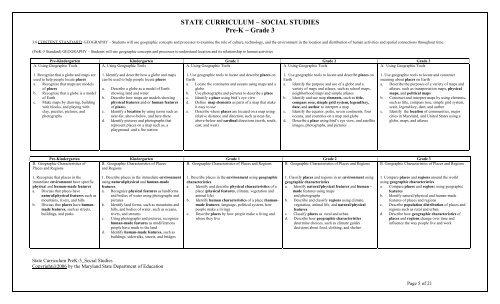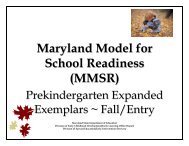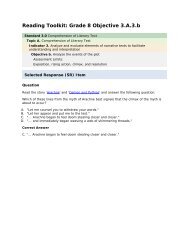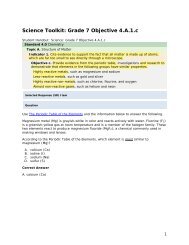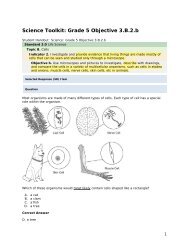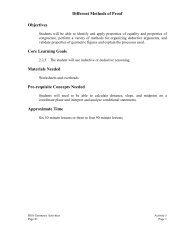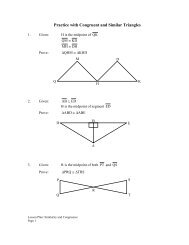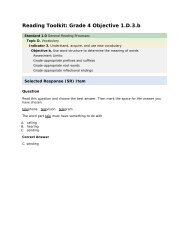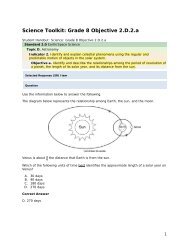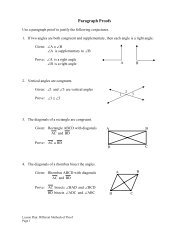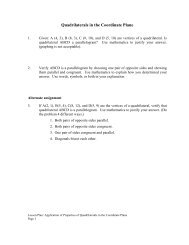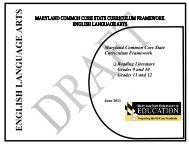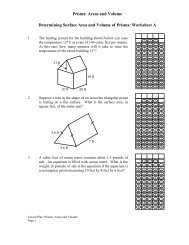Maryland State Curriculum - mdk12
Maryland State Curriculum - mdk12
Maryland State Curriculum - mdk12
- TAGS
- maryland
- curriculum
- mdk12.org
Create successful ePaper yourself
Turn your PDF publications into a flip-book with our unique Google optimized e-Paper software.
<strong>State</strong> <strong>Curriculum</strong> PreK-3_Social Studies<br />
Copyright@2006 by the <strong>Maryland</strong> <strong>State</strong> Department of Education<br />
STATE CURRICULUM – SOCIAL STUDIES<br />
Pre-K – Grade 3<br />
3.0 CONTENT STANDARD: GEOGRAPHY – Students will use geographic concepts and processes to examine the role of culture, technology, and the environment in the location and distribution of human activities and spatial connections throughout time.<br />
(PreK-3 Standard) GEOGRAPHY – Students will use geographic concepts and processes to understand location and its relationship to human activities<br />
Pre-Kindergarten Kindergarten Grade 1 Grade 2 Grade 3<br />
A. Using Geographic Tools<br />
A. Using Geographic Tools<br />
A. Using Geographic Tools<br />
A. Using Geographic Tools<br />
A. Using Geographic Tools<br />
1. Recognize that a globe and maps are<br />
used to help people locate places<br />
a. Recognize that maps are models<br />
of places<br />
b. Recognize that a globe is a model<br />
of Earth<br />
c. Make maps by drawing, building<br />
with blocks, and playing with<br />
clay, puzzles, pictures, and<br />
photographs<br />
1. Identify and describe how a globe and maps<br />
can be used to help people locate places<br />
a. Describe a globe as a model of Earth<br />
showing land and water<br />
b. Describe how maps are models showing<br />
physical features and/or human features<br />
of places<br />
c. Identify a location by using terms such as<br />
near-far, above-below, and here-there<br />
d. Identify pictures and photographs that<br />
represent places on a map such as, a<br />
playground and a fire station<br />
1. Use geographic tools to locate and describe places on<br />
Earth<br />
a. Locate the continents and oceans using maps and a<br />
globe<br />
b. Use photographs and pictures to describe a place<br />
c. Identify a place using bird’s eye view<br />
d. Define map elements as parts of a map that make<br />
it easy to use<br />
e. Describe where places are located on a map using<br />
relative distance and direction, such as near-far,<br />
above-below and cardinal directions (north, south,<br />
east, and west)<br />
1. Use geographic tools to locate and describe places on<br />
Earth<br />
a. Identify the purpose and use of a globe and a<br />
variety of maps and atlases, such as school maps,<br />
neighborhood maps and simple atlases<br />
b. Identify and use map elements, such as title,<br />
compass rose, simple grid system, legend/key,<br />
date, and author to interpret a map<br />
c. Identify the equator, poles, seven continents, four<br />
oceans, and countries on a map and globe<br />
d. Describe a place using bird’s eye view, and satellite<br />
images, photographs, and pictures<br />
1. Use geographic tools to locate and construct<br />
meaning about places on Earth<br />
a. Describe the purposes of a variety of maps and<br />
atlases, such as transportation maps, physical<br />
maps, and political maps<br />
b. Construct and interpret maps by using elements,<br />
such as title, compass rose, simple grid system,<br />
scale, legend/key, date, and author<br />
c. Identify the location of communities, major<br />
cities in <strong>Maryland</strong>, and United <strong>State</strong>s using a<br />
globe, maps, and atlases<br />
Pre-Kindergarten Kindergarten Grade 1 Grade 2 Grade 3<br />
B. Geographic Characteristics of B. Geographic Characteristics of Places<br />
B. Geographic Characteristics of Places and Regions B. Geographic Characteristics of Places and Regions B. Geographic Characteristics of Places and Regions<br />
Places and Regions<br />
and Regions<br />
1. Recognize that places in the<br />
immediate environment have specific<br />
physical and human-made features<br />
a. Discuss that places have<br />
natural/physical features such as<br />
mountains, rivers, and hills<br />
b. Discuss that places have humanmade<br />
features, such as streets,<br />
buildings, and parks<br />
1. Describe places in the immediate environment<br />
using natural/physical and human-made<br />
features<br />
a. Recognize physical features as landforms<br />
and bodies of water using photographs and<br />
pictures<br />
b. Identify land forms, such as mountains and<br />
hills, and bodies of water, such as oceans,<br />
rivers, and streams<br />
c. Using photographs and pictures, recognize<br />
human-made features as modifications<br />
people have made to the land<br />
d. Identify human-made features, such as<br />
buildings, sidewalks, streets, and bridges<br />
1. Describe places in the environment using geographic<br />
characteristics<br />
a. Identify and describe physical characteristics of a<br />
place (physical features, climate, vegetation and<br />
animal life)<br />
b. Identify human characteristics of a place (humanmade<br />
features, language, political system, how<br />
people make a living)<br />
c. Describe places by how people make a living and<br />
where they live<br />
1. Classify places and regions in an environment using<br />
geographic characteristics<br />
a. Identify natural/physical features and human –<br />
made features using maps<br />
and photographs<br />
b. Describe and classify regions using climate,<br />
vegetation, animal life, and natural/physical<br />
features<br />
c. Classify places as rural and urban<br />
d. Describe how geographic characteristics<br />
determine choices, such as climate guides<br />
decisions about food, clothing, and shelter<br />
1. Compare places and regions around the world<br />
using geographic characteristics<br />
a. Compare places and regions using geographic<br />
features<br />
b. Identify natural/physical and human-made<br />
features of places and regions<br />
c. Describe population distribution of places and<br />
regions such as rural and urban<br />
d. Describe how geographic characteristics of<br />
places and regions change over time and<br />
influence the way people live and work<br />
Page 5 of 21


